Grain Stockpiles Mounting as Prices Continue Falling
TOPICS
Soybeans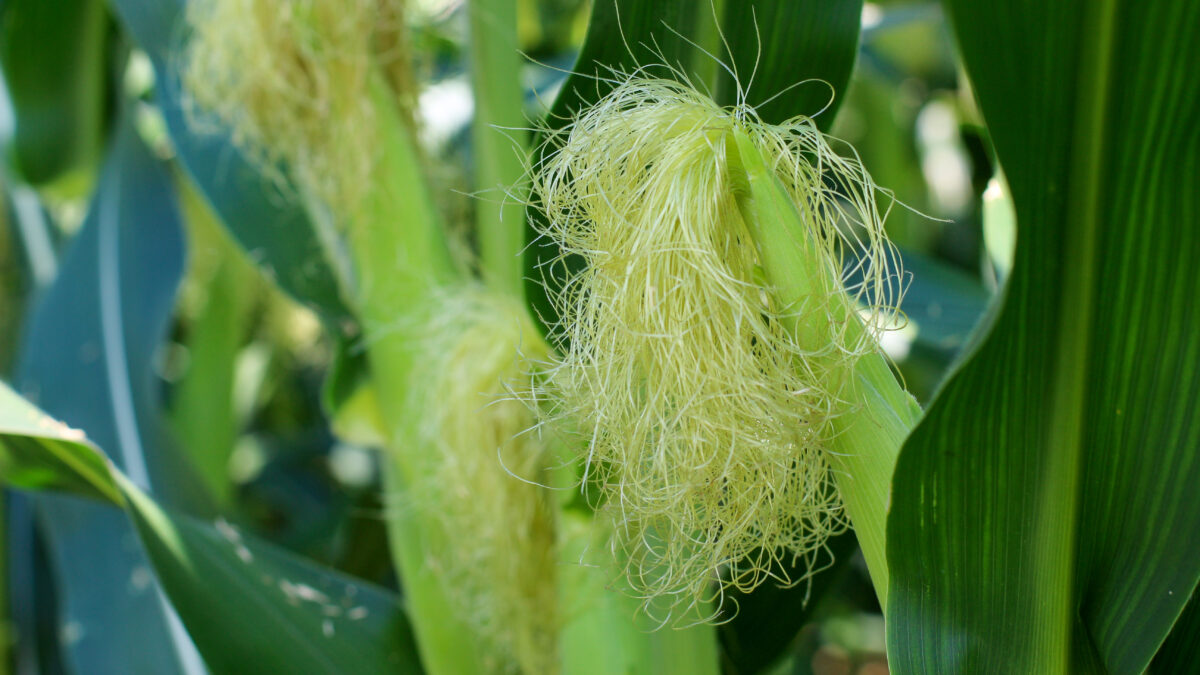
photo credit: Tennessee Farm Bureau, Used with Permission
John Newton, Ph.D.
Vice President of Public Policy and Economic Analysis
USDA’s quarterly Grain Stocks report provides survey-based estimates of all whole grains and oilseeds stored on farm operations or stored off-farm in commercial grain storage facilities. This grain storage report also provides an opportunity to estimate the disappearance, i.e. domestic use and exports, of grains and oilseeds during the previous quarter. The June 29 Grain Stocks report revealed corn inventory at 5.31 billion bushels as of June 1, up 77 million bushels, or 1.4 percent, from prior-year levels. Soybeans in inventory totaled 1.22 billion bushels as of June 1, 256 million bushels, or 26.5 percent, above 2017 levels. These June 1 inventory levels were record-high for soybeans and the third-highest level reported for corn.
While inventory levels were at or near all-time highs, so too was implied consumption of corn and soybeans. Corn disappearance from March 1 to June 1 was a record 3.6 billion bushels, 193 million bushels, or 6 percent, above prior-year levels. Soybean disappearance was a record 888 million bushels, up 155 million bushels, or 15 percent, from 2017 consumption levels. Record consumption levels are not unanticipated as USDA projected corn use during 2017/18 to increase 1 percent to a record 14.8 billion bushels, and for soybean use to remain in line with the prior-year’s record of 4.2 billion bushels.
On- and Off-Farm Storage
The grain stocks report is the result of two separate surveys. The on-farm survey is based on a sample of approximately 70,500 farm operators. A subset of these farm operators are asked to provide the total quantities of grain stored on their operations as of June 1. This includes all whole grains and oilseeds stored, whether for feed, seed or sale, as well as any stored under a government program. The off-farm survey is based on all known commercial grain storage facilities and includes 8,500 facilities with storage capacity of 11.2 billion bushels. USDA uses both survey results to estimate total grains and oilseeds in storage.
On-Farm Storage
More than 50 percent of all corn in storage as of June 1 was stored on-farm. As of June 1, farmers were storing 2.75 billion bushels of corn, down 3 percent, or 91 million bushels, from prior-year levels. Many of the states in the Corn Belt saw lower corn inventory levels. For example, farmers in Iowa are holding 50 million fewer bushels than last year. Nebraska and South Dakota each are holding 25 million fewer bushels this year. Meanwhile, Kentucky growers are holding 11 million more bushels than last year. Figure 1 highlights the year-over-year change in on-farm corn storage levels.
While a majority of the corn in storage is on-farm, only 31 percent of soybeans in storage are held on the farm. On-farm soybean inventories totaled 377 million bushels, up 13 percent, or 44.5 million bushels, from prior-year levels. Illinois farmers were holding 26 million more bushels, followed by Iowa farmers holding 9 million additional bushels. Ohio saw the largest decline in soybean inventory levels, holding 3 million fewer bushels on June 1 than at this time in 2017. Figure 2 highlights the year-over-year change in on-farm soybean storage levels.
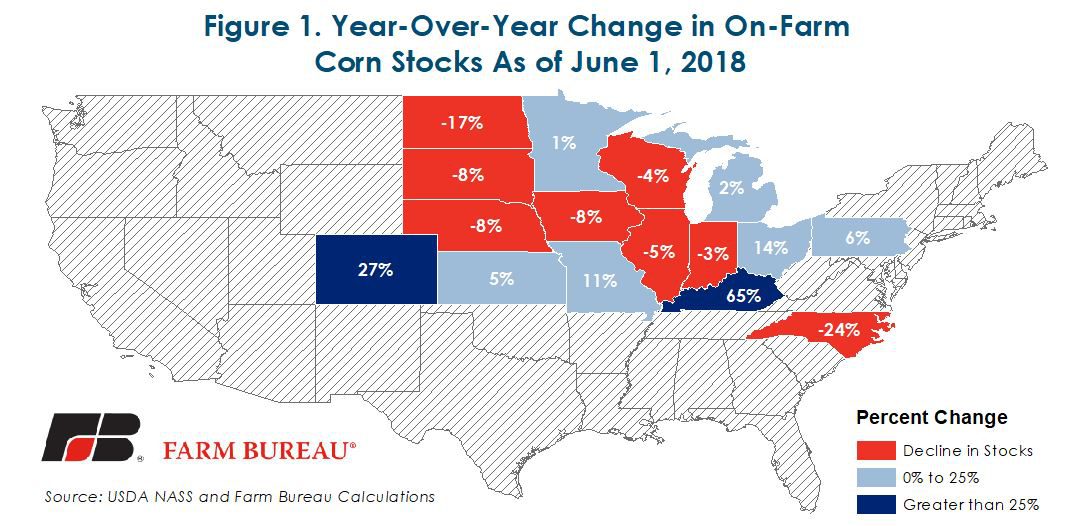
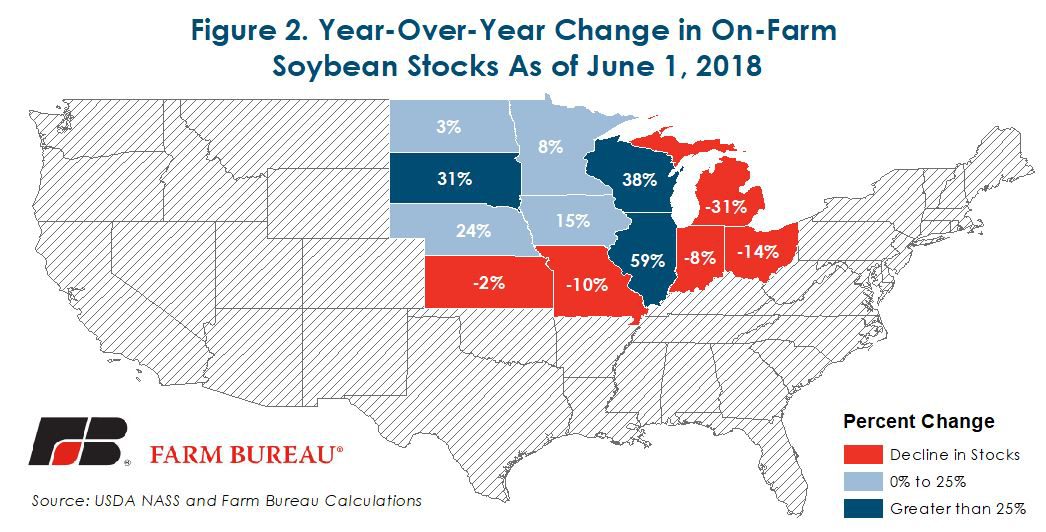
Off-Farm Storage
As of June 1, off-farm commercial storage facilities were carrying 2.6 million bushels, up 168 million bushels, or 7 percent, from prior-year levels, representing 48 percent of all corn in storage. Many states across the Corn Belt saw higher inventory levels in off-farm storage. Illinois added 86 million bushels, Kansas added 37 million bushels and Indiana added 21 million bushels of corn in storage. North and South Dakota saw large declines in corn inventory, down 14 million bushels and 7 million bushels, respectively. Figure 3 highlights the year-over-year change in off-farm corn storage levels
Nearly 70 percent of all soybeans in storage as of June 1 was held in commercial storage facilities. Off-farm soybeans in storage totaled 845 million bushels, up 211 million bushels, or 33 percent, from prior-year levels. Large increases in storage were observed across much of the western Corn Belt and Upper Midwest. Illinois had 59 million additional bushels in storage, followed by Iowa with 33 million bushels and Nebraska with 22 million bushels over prior-year levels. Maryland and Washington saw large declines in soybeans in storage, down 6 million bushels and 2 million bushels, respectively. Figure 4 highlights the year-over-year change in off-farm soybean storage levels
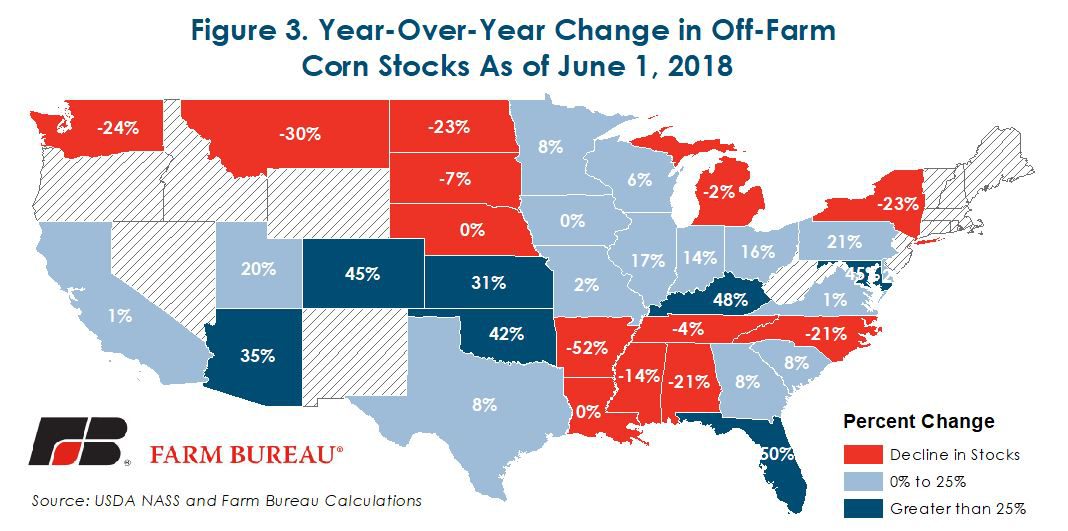
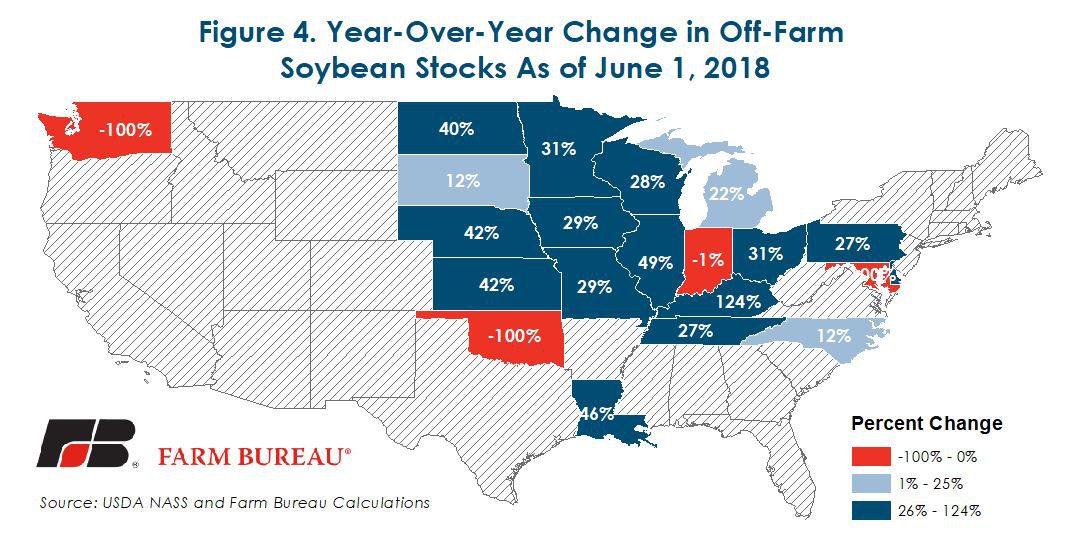
Billion Dollar Question
As of June 1, off-farm commercial storage levels for both corn and soybeans have increased above prior-year levels. Farmers are holding less corn in storage and instead have reserved more storage capacity for soybeans. Combined, the amount of corn and soybeans in storage is at or near record levels.
Marketing of the old crop has also been record-high over the last quarter. The pace must continue. If USDA projections for ending stock levels of 2.1 billion bushels of corn and 505 million bushels of soybeans are to be realized, farmers and commercial storage facilities need to market 3.2 billion bushels of corn and 715 million bushels of soybeans during the last three months of the marketing year.
The concern, today, however, is at what price will old crop leave the bins to make room for this fall’s harvest. July corn futures traded below $3.40 per bushel in recent weeks and now sit 70 cents per bushel below the mid-May settlement price. Similarly, July soybeans are trading at $8.44 per bushel, nearly $2.40 per bushel below the contract highs reached in March.
For stockholders who forward sold corn or soybeans in advance of the price declines, recent price movements may not impact their bottom line as significantly. However, for those who remain in the cash market, the recent price volatility has likely resulted in a much more significant impact on farm or agribusiness profitability.
Top Issues
VIEW ALL